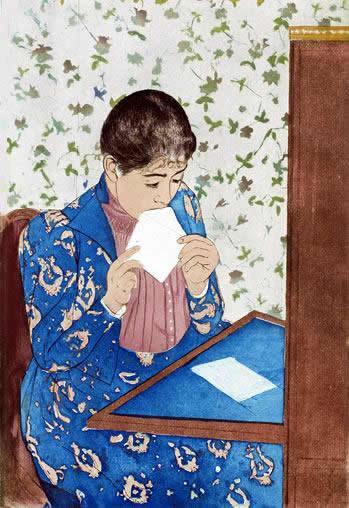This event flooded Europe and all other continents with Japanese goods and Japanese prints, where this gave an impressive impression on Parisian artists. This resulted with famous artists got to painting with this new style as this was something new and left the artists impressed with this big difference in arts. Artists were impressed with the lack of shadows, perspective, flatness, strong bold colours, off centre subjects,
Even Claude Monet had to buy a print, which he have hung up in his studio and resulted to be painted in Emile Zola's portrait background, Emile Zola have even stated that Japanese prints are the First and most perfect impressions. Even Vincent Van Gogh even got impressed with this style, as he painted impressions of waves in his paintings too.
This style got in all paintings, and one French art critic named this movement - JAPONISME - which goes back to 1872.
This style was even giving a boost in posters of plays, dances and anything you could imagine of.
Even Claude Monet had to buy a print, which he have hung up in his studio and resulted to be painted in Emile Zola's portrait background, Emile Zola have even stated that Japanese prints are the First and most perfect impressions. Even Vincent Van Gogh even got impressed with this style, as he painted impressions of waves in his paintings too.
This style got in all paintings, and one French art critic named this movement - JAPONISME - which goes back to 1872.
This style was even giving a boost in posters of plays, dances and anything you could imagine of.
This revolution in art even opened centres where one can buy oriental stuff where everyone was filling their homes with blue and white porcelain and oriental pieces that even consisted of pearls and so on.

Monet - Emile's Protrait (middle top -Japanese print)

The wave impression - Vincent van Gogh

Monet - Emile's Protrait (middle top -Japanese print)

The wave impression - Vincent van Gogh

Marie Cassatt - Japonisme (clothing, flatness, strong bold colours)
_1892.jpg/170px-Lautrec_reine_de_joie_(poster)_1892.jpg)
Japonisme Style Poster
(4/4) Hokusai - Private life of a Masterpiece - YouTube. 2013. (4/4) Hokusai - Private life of a Masterpiece - YouTube. [ONLINE] Available at:http://www.youtube.com/watch?v=0RuBDt0RNbA.
Japonism - Wikipedia, the free encyclopedia. 2013. Japonism - Wikipedia, the free encyclopedia. [ONLINE] Available at:http://en.wikipedia.org/wiki/Japonism.
This comment has been removed by the author.
ReplyDeleteIn my opinion, even though it is clear that some of these European artists admired Japanese art, they copied it and transformed a whole new category of art. They often added bold and brash colors like bright yellows, reds and oranges whereas in Japanese paintings with the same subject matter the tone would be softer and cooler colors used. As much as they comment that they love the simplicity of Japanese paintings, artists like Van Gogh would twist the Japanese style add a chaos of detail in the background and distracting color combinations. It is interesting how in their attempt to replicate, they still created something brand new.
ReplyDelete